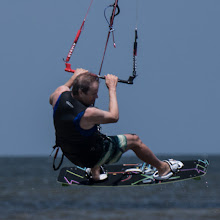It seems US Sailing didn’t have all the information before casting three votes for kitesurf course racing at the expense of windsurf racing for the 2016 Olympics. A more careful evaluation questions Dean Brenner’s explanation for the U.S. votes at the ISAF Council.
1. No argument, kiteboarding is an exciting and rapidly growing area of the sport. However, US Sailing and ISAF voted for what is currently practiced by a very small percentage of kiteboarders - kiteboard course racing. That’s like noticing all these skiers at the mountain and then choosing telemark racing as the Olympic discipline. Kite board racing uses very different equipment and skills than what you see at the beach. No doubt kiteboard racing is cutting edge and could one day evolve into an Olympic sport, but we’re just not there yet. That’s the point. There are estimates that at most 200-300 persons world-wide have been on a kite course board. This includes but a handful of juniors.
But let’s look at the facts: 80 women from 37 countries competed in the RS:X World Championships. 12 women from 10 countries competed in the Kite Course Racing World Championships. Only two women were able to complete all the races at the Kite Course Worlds. Does this qualify as Olympic-ready for 2016?
There is currently no known active Youth Kite Course Racing. Compare that to 400 kids (age 16 and younger) who are expected at the Techno Windsurfing World Championships this summer.
2. According to Dean/US Sailing’s justification, 'The infrastructure required will be minimal.' Agreed, infrastructure required for staging events is an important consideration. I wonder if US Sailing is aware that kitesurfing, due to safety concerns, is prohibited from many premier ISAF sailing venues:
In Sydney Harbour, site of the 2000 Olympics, kitesurfing is banned.
In Singapore, site of the 2010 Youth Olympic Games, kitesurfing in banned.
In Cyprus, site of the 2013 ISAF Youth Worlds, kitesurfing is banned.
In Lake Garda, Italy, site of the EUROSAF Olympic Regatta, kitesurfing is banned.
 |
In the hospital after kitesurfing - Calling out U.S. Sailing to explain their Olympic vote - Nevin Sayre
|
On top of that, kitesurfers require the ability to change kite sizes if wind conditions change between races. The ISAF Kite Equipment Report glosses over basic logistics and says huge floating platforms could be built to launch from, or competitors can launch from support boats, or be shuttled to launch from outside beaches. That’s minimal infrastructure????? There are very few venues without surrounding hazards where you can safely launch 140 kites to make a 9:00 AM start time in gusty, stormy conditions.
3. Dean’s third reason, 'The potential exists to bring new countries to the sport of Olympic Sailing' is valid. And windsurfing has done exactly that with 54 countries competing in the Olympic Qualifying events, and more MNAs competing in Men’s RS:X at the ISAF World Championships than any other class, including Laser. Does US Sailing/ISAF want to trade this success for a class that is not yet developed?
4. 'Kites can be sailed close to shore, increasing spectator possibilities.' Yes, just as easily as windsurfing. The only difference is, if the wind is on shore, all those ISAF spectators would have to be pushed back from the shoreline to avoid decapitation.
5. Dean goes on to rely on the ISAF Equipment Evaluation Report which barely addresses the critical concerns of safety. While it’s true that kites have improved in safety, and expert kiters will take their own risks, what about the safety of juniors pursing the Olympic dream? You can’t just hook a hot shot Opti sailor up to a kite and push him/her off the dock. There is zero pathway for kiting currently within US Sailing.
In his position as Olympic Sailing Chairman, Dean Brenner may not be concerned with further down the pyramid, but safety in the Olympic pipeline should be of paramount importance to US Sailing. Again I ask, what is US Sailing’s plan to safely incorporate kitesurfing into Junior Sailing Programs, the Olympic Youth Development Team, Youth Worlds Team, the Junior Olympic events, and all the pathways that leads to the Olympics? What is US Sailing’s plan to bring kitesurfing under its umbrella when insurance companies have deemed kitesurfing unsafe?
ISAF’s own specialists in the Events Committee voted 17-2 in favor of trialing kitesurfing at ISAF events until it is proven Olympic-ready, and keeping RS:X as the Olympic Class for Men’s and Women’s in 2016. We call on U.S. Sailing and ISAF to evaluate the readiness of kitesurf racing for 2016 and the Olympic pipeline, question dubious claims in the ISAF Kite Evaluation Report, balance judgement against the world-wide success of windsurfing as an Olympic discipline, and perform a complete fair analysis before their vote in the November ISAF meeting.
Sincerely,
Nevin Sayre - US Sailing Member
